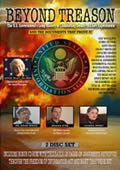HOW WALL STREET HIJACKED TARP
By
Jon Christian Ryter
August 1, 2012
NewsWithViews.com
Neil Barofsky, a lifetime Democrat, was picked by then-President George W. Bush (on the advise of his Treasury Secretary Henry Paulson) to police how the banks spent the $700 billion in TARP economic stimulus funds that should have helped the United States avert the recession that all Americans now suffer under. Testifying before the Senate Finance Committee on April 20, 2010, Barofsky said: "To declare TARP a success is revisionist history. TARP was supposed to restore lending, and that didn't happen."
TARP, according to the political rhetoric, was supposed to buy up the foreclosed mortgages that were strangling credit and bankrupting both small business entrepreneurs and working class stiffs who were impacted by the lack of financial liquidity in the United States that was caused, initially, by the collapse of Indonesia's largest financial institution, Bank Century when it lost 6.7 trillion rupiah ($720 million). That bank failure came on the heels of the insolvency of Indonesia's central bank, Bank Indonesia a decade earlier. The money Bank Century lost was owed to—you guessed it—America's Wall Street banks who advanced them massive loans to modernize their infrastructure: roads and critical services to prepare them for the transnational princes of industry bringing the third world into the 21st century—with American factories and American jobs.
The exporting of US jobs to the third world that began with the never constitutionally ratified North American Free Trade Agreement enacted by the 103rd Congress (which can be repealed since it's a law and not a treaty), created the economic mechanism that, combined with another Clinton-era law orchestrated by then community-organizer Barack Obama in Chicago that forced Illinois banks to make bad mortgage loans to minorities that Fannie Mae had agreed to underwrite. In 1999, Bill Clinton's Republican-controlled 106th Congress amended Public Law 95-128, 12 USC § 2901, Jimmy Carter's 1977 Community Reinvestment Act to reduce what that legislation called discriminatory credit practices against minorities in impoverished areas—a banking practice known as "red-lining." The Clinton law, actually concocted by Republicans to curry favor from minorities voters, the Gramm-Leach-Bliley Act, was officially known as The Financial Services Modernization Act of 1999. It forced banks to make home loans guaranteed by Fannie Mae to low income families who were not "sound financial risks" for mortgages. It should have been called "The Mortgage Industry Implosion Time Bomb Act of 1999" because the 106th Congress lit the fuse. It took six years for the economic time bomb to explode and for the American mortgage industry to implode.
TARP would have repaired the economy had the funds allocated to get the damaged mortgage assets off the books of the lenders and into the hands of the Resolution Trust Corporation been solidified by legislation and not just rhetoric. TARP should have freed up credit with local banks and averted most of the financial crisis in the United States with small mortgage lenders—many of whom were declared insolvent by the Federal Reserve System. Once declared insolvent, those banks were swallowed up by the same major Wall Street Banks who caused the problem, and who needed the cash reserves of the "declared bankrupt" banks to buffer their own liquidity as the Fed funneled the TARP money to banks they viewed as "too big to fail." Some of that money was used to buy "declared bankrupt" banks in the United States. Some of it was loaned to third world banks to keep them from going belly-up since, regardless of their size, no third world bank was viewed as "too big to fail."
In his book, Bailout: Why TARP Failed, Barofsky said that Washington used our tax dollars to abandon Main Street while rescuing Wall Street. Barofsky said when he got to Washington he "...saw that Washington had been hijacked by a small group of very powerful Wall Street Banks. They captured regulators ideology...and what I saw was TARP went from a program that was supposed to help Main Street reinvigorate the economy, restart the economy and help homeowners, turn into a program that really only served the financial elites on Wall Street."
While Barofsky admitted that, in part, TARP was supposed to plug up the leaks and prevent a gigantic financial collapse and restore confidence in the financial system, "...throwing a few billion dollars at the largest banks, plus trillions of dollars of other support, just to preserve what is essentially a broken status quo, that benefits really financial executives and institutions...that's why Congress and Treasury promised more. They promised the banks would take this money and use it to pour it into the economy and bring back the economic growth which hasn't happened because the way it was mismanaged." Congress promised. But TARP didn't get passed. The money was allocated, but the super majority Democratic Party under Nancy Pelosi and Harry Reid in 2007 never created the legislative tools get the allocated funds from the Treasury into the hands of the Resolution Trust Company in order to help troubled homeowners.
Barofsky, who was appointed by Bush but arrived to assume his job after Obama took office, told CBS News that once you arrive in DC, you discover the "...capture in Washington is not Republican or Democrat. It crosses political barriers—and, it's a major problem for this country." CBS defended Obama's use of TARP money—and going back for $823 billion more—noting that Obama saved the auto industry.
| Subscribe to the NewsWithViews Daily News Alerts! |
Barofsky nodded, saying: "I was one of the first people outside of the Treasury bubble to say that...But you can't look at a program that narrowly. This program was supposed to do a lot more for the American people. And, it wasn't an accident. It wasn't happenstance. This was a series of choices. This was the choice not to deploy TARP funds to help Main Street, and to help homeowners. That's what they were supposed to do. That's what they promised to do...The housing program was supposed to spend $50 billion (to help homeonwers). They spent three. That means (the Obama Treasury Department) chose to spend more money to bail out American Express—a credit card company—than it did to deal with the foreclosure crisis that's holding our economy back."
Barofsky emphasized that TARP failed because of "...the horrific mismanagement of the program. And, the real question of what the program's goals really were." Barofsky pointed out that Obama Administration officials complained that Congress was stopping them when they weren't. Through mediocre management by Obama appointees, hundreds of billions of TARP dollars were simply left on the table and not spent to help homeowners.













 Share
This Article
Share
This Article






